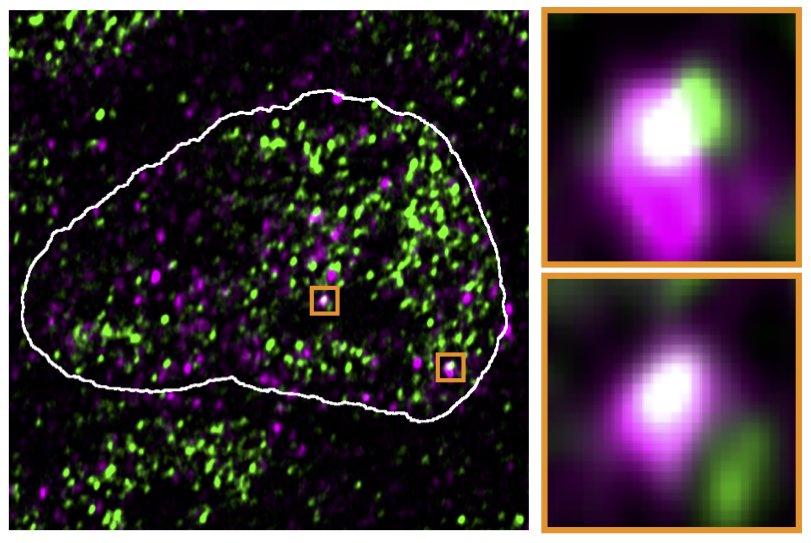Ancient dormant sequences in the genome impact embryonic development in unexpected ways
The mammalian genome contains retroviral sequences that are in an undead but mostly "harmless" state. An international research team recently discovered how some of these retroviral gene fragments affect embryonic cells if they are unleashed. Unexpectedly, not the viral proteins, but rather copies of the genetic material itself generate an imbalance in the cell.

In the nucleus of mouse stem cells, derepressed endoviral RNA molecules (purple) appear at the same spots as condensates containing RNA polymerase II (green), as this fluorescence microscopic image shows.
© Asimi et al., MPIMG
Over thousands of years of evolution, countless viruses have embedded themselves in our genome. A staggering ten percent of mammalian genomes consist of ancient retroviral sequences. These no longer seem to pose any danger, because most of them have mutated beyond recognition. Additionally, these genes have been epigenetically silenced by the cell. But as the silencing of the viral remains fails, they will rise from their graves, causing chaos in the cell.
"We found that the messenger copies of some of the viral genes, the RNA, have an important impact on embryonic cells," says Denes Hnisz, research group leader at the Max Planck Institute for Molecular Genetics in Berlin. "The viral sequences seem to remember their original mission of hijacking the molecular machinery that ensures the flow of information from DNA to RNA to protein. Interestingly, the messenger RNA itself seems to be responsible."
Hnisz' team and collaborating researchers describe that the RNA of the resurrected viruses exerts attractive forces on the enzymes that read the information from the DNA. The tasks of the embryonic cell - such as reading important embryonic genes - are neglected and a fatal imbalance develops. This unleashed state occurs, for example, in some types of cancer and neurological diseases.
Mostly harmless viral remains
Viruses are cleverly constructed snippets of genetic information. Some of them incorporate themselves into the genome of their hosts and persist there. Thousands of copies of Endogenous Retroviruses (ERVs) have spread throughout mammalian genomes, often in droves of hundreds of repetitive copies.
"As retroviruses jump from one section of DNA to the next during their life cycle, they can alter genes and even recombine them. This makes them an important tool for evolution to create new genes," says Henri Niskanen, one of the scientists involved in the study. "For an individual organism however, uncontrolled gene modification does not bode well, especially during embryonic development." This is why the cell will identify ERV sequences and recruit dedicated repressive machinery to their sites and keep them silent. Additionally, the chromosome is getting compacted at these sites.
Resurrected viruses hijack transcriptional machinery
But what happens if you turn off these protective mechanisms? The research team wanted to find out what is the very first thing that happens when the ERV zombies are no longer kept in check. For this purpose, they removed Trim28, a protein that is responsible for silencing the viral remnants, from embryonic stem cells of mice, and monitored the immediate consequences.






